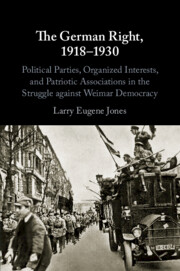 The German Right, 1918–1930
The German Right, 1918–1930 Book contents
- The German Right, 1918–1930
- The German Right, 1918–1930
- Copyright page
- Dedication
- Contents
- Figures
- Acknowledgments
- Abbreviations
- Introduction
- 1 Revolution and Realignment
- 2 Infrastructure of the German Right
- 3 Forging a Conservative Synthesis
- 4 Growth and Consolidation
- 5 The Radical Right
- 6 1923 – A Missed Opportunity?
- 7 From Triumph to Schism
- 8 Stabilization from the Right?
- 9 Paladins of the Right
- 10 A Resurgent Nationalism
- 11 The Road Back to Power
- 12 The Burden of Responsibility
- 13 From Defeat to Crisis
- 14 Reverberations and Realignment
- 15 The Chimera of Right-Wing Unity
- 16 Schism and Fragmentation
- 17 The Brüning Gambit
- 18 The September Earthquake
- Epilogue
- Select Bibliography
- Index
7 - From Triumph to Schism
Published online by Cambridge University Press: 21 March 2020
- The German Right, 1918–1930
- The German Right, 1918–1930
- Copyright page
- Dedication
- Contents
- Figures
- Acknowledgments
- Abbreviations
- Introduction
- 1 Revolution and Realignment
- 2 Infrastructure of the German Right
- 3 Forging a Conservative Synthesis
- 4 Growth and Consolidation
- 5 The Radical Right
- 6 1923 – A Missed Opportunity?
- 7 From Triumph to Schism
- 8 Stabilization from the Right?
- 9 Paladins of the Right
- 10 A Resurgent Nationalism
- 11 The Road Back to Power
- 12 The Burden of Responsibility
- 13 From Defeat to Crisis
- 14 Reverberations and Realignment
- 15 The Chimera of Right-Wing Unity
- 16 Schism and Fragmentation
- 17 The Brüning Gambit
- 18 The September Earthquake
- Epilogue
- Select Bibliography
- Index
Summary
Chapter 7 examines the DNVP’s reaction to the stabilization of Germany’s republican system under the auspices of a new government formed by the Center Party’s Wilhelm Marx in January 1924. In the campaign for the May 1924 Reichstag elections, the DNVP not only did its best to dissociate itself from the anti-social consequences of stabilization, but moved racism and antisemitism to the forefront of its campaign in an attempt to preempt attacks from the racists that had bolted the party in 1922. The result was a stunning victory at the polls that made its delegation the largest in the Reichstag. But with success comes responsibility, and the DNVP was suddenly faced with the task of voting for the Dawes Plan, a plan that in the campaign it had denounced as a “second Versailles.” In the decisive vote in August 1924, the Nationalist delegation to the Reichstag split right down the middle in a dramatic turn of events that only highlighted how deeply divided the DNVP was as it faced the prospect of governmental responsibility.
Keywords
- Type
- Chapter
- Information
- The German Right, 1918–1930Political Parties, Organized Interests, and Patriotic Associations in the Struggle against Weimar Democracy, pp. 207 - 240Publisher: Cambridge University PressPrint publication year: 2020
